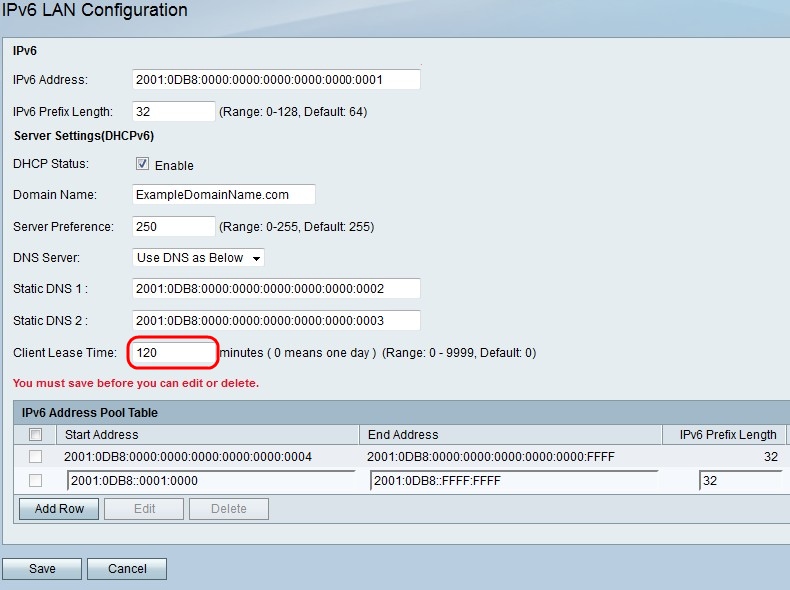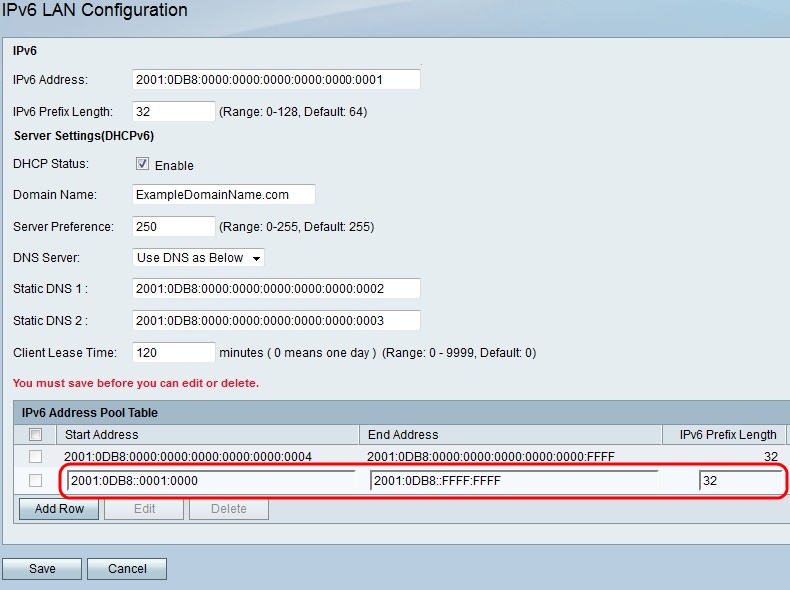IPv6 LAN Configuration on RV215W
Available Languages
Objective
IPv6 is the newest version of IP and is designed to replace the current IPv4 system. Since IPv4 addresses are near depletion, IPv6 has gained popularity. IPv6 offers a much larger amount of IP addresses than IPv4. Configuration of IPv6 now helps make a network ready for the future of computer networking. This article explains how to configure IPv6 LAN settings on the RV215W.
Applicable Devices
• RV215W
Software Version
• 1.1.0.5
IPv6 LAN Configuration
IPv6 Mode Configuration
The RV215W must have the LAN set to IPv6 to allow IPv6 configuration. This procedure explains how to configure the LAN IP mode for IPv6 on the RV215W.
Step 1. Log in to the web configuration utility and choose Networking > IP Mode. The IP Mode page opens:

Step 2. From the IP Mode drop-down list, choose LAN:IPv6, WAN:IPv4, LAN:IPv6, WAN:IPv6, LAN:IPv4+IPv6, WAN:IPv4, or LAN:IPv4+IPv6, WAN:IPv4+IPv6. These options allow IPv6 to be used on the LAN interfaces.
Step 3. Click Save.
IPv6 LAN Configuration
This procedure explains how to configure the LAN settings for IPv6.
Step 1. Log in to the web configuration utility and choose Networking > IPv6 >IPv6 LAN Configuration. The IPv6 LAN Configuration page appears:

Step 2. In the IPv6 Address field, enter an IPv6 address to use as the LAN interface IPv6 address. IPv6 addresses can be entered with or without double-colon notation.
Step 3. In the IPv6 Prefix Length field, enter the length of the network portion of the IPv6 address.
Step 4. To set the RV215W as an IPv6 DHCP server, check the Enable check box in the DHCP Status field. A DHCP server automatically assigns an IPv6 address to devices when they connect to the LAN.

Step 5. (Optional) In the Domain Name field, enter a domain name for the DHCP server.
Step 6. Enter the server preference level for the RV215W DHCP server in the Server Preference field. If multiple DHCP servers exist in a network, the server with the highest preference level is allowed to assign the addresses.
Step 7. From the DNS Server drop-down list, choose an option. A Domain Name System (DNS) server maps IP addresses to a domain names entered by an user.
• Use DNS Proxy — This option uses a proxy DNS server.
• Use DNS from ISP — This option uses the DNS servers provided by the ISP.
• Use DNS as Below — This option uses up to two specified DNS servers.

Step 8. If you chose Use DNS as Below in Step 7, enter the IPv6 address of the primary DNS server to use on the IPv6 network in the Static DNS 1 field.
Step 9. If you chose Use DNS as Below in Step 7, enter the IPv6 address of the secondary DNS server to use on the IPv6 network in the Static DNS 2 field.

Step 10. In the Client Lease Time field, enter how long (in minutes) an address is leased to a client. A value of 0 means that the client can use the address for one day.
Step 11. To add a new IPv6 address pool, click Add Row in the IPv6 Address Pool Table, or to edit an existing pool, check the check box for the pool and click Edit. An address pool is a range of IP addresses that are assigned to the DHCP clients.

Step 12. In the Start Address field, enter the first value of the IPv6 address pool.
Step 13. In the End Address field, enter the last value of the IPv6 address pool.
Step 14. In the IPv6 Prefix Length field, enter the prefix length of the pool.
Step 15. Click Save.
 Feedback
Feedback